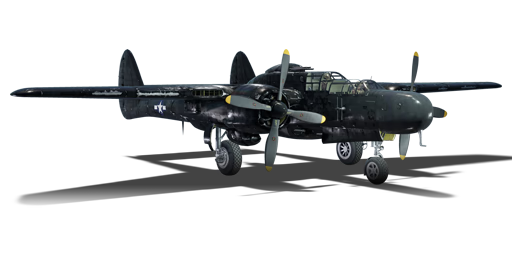



The P-61C-1 is an American twin-engine fighter. It was introduced in Update 1.57 "Battle March".
The Northrop P-61C-1 Black Widow is a heavy twin-engine strike fighter designed as the USAAF's first dedicated night-fighter and aircraft outfitted with radar. Though a large aircraft with a crew of three (pilot, turret gunner and radio/radar operator/gunner), the Black Widow utilised its speed, radar, and weapons advantages to dispatch enemy aircraft in the dead of night.
The P-61C-1 is powered by dual Pratt & Whitney R-2800-73 double wasp engines, the same engines which powered the Republic P-47N Thunderbolt. The one difference between the Thunderbolt's -57C and the -73s built explicitly for the P-61 was each had a General Electric CH-5-A3 turbocharger installed. The modified engines allowed the P-61C-1 to fly at all altitudes effectively. While outfitted with powerful engines, turning the aircraft causes loss of energy, and such manoeuvres should be limited as places the aircraft in vulnerable situations.
One of the roles of the P-61C-1 is to operate as a bomber interceptor. During these operations, if detected, the heavy fighter is likely to encounter defensive fire. To increase survivability and protection of the crew, the Black Widow utilizes various bulletproof glass and armour protective plates throughout the fighter. The gunner who operates the remote turret has the option to utilise armour plates, which fold out of the way when not in use. The crew member sitting in the aft of the aircraft has the least amount of armour protection but is the least likely to be shot at unless being attacked from the rear.
The armament configuration of the P-61C-1 is unique compared to most fighters which either utilise nose-mounted or wing-mounted guns. The Black Widow incorporates two weapon systems, the first consisting of four 20 mm AN/M2 autocannons mounted in the belly of the aircraft with 200 RPG, or 800 rounds total. Convergence is not a factor when utilising these guns. The aircraft also incorporates a dorsal turret outfitted with four 50 calibre machine guns (2,120 rounds or 530 RPG), which can be remotely operated by the gunner or the radio/radar operator. The turret has 360-degree mobility and can fire at elevations up to 90-degrees. The turret cannot depress lower than horizontal or else it would risk firing into the wings, cockpit, tail booms or tail section. The dorsal turret is utilised for both offensive and defensive uses.
flaps
flaps
flaps
brake
| Belt | Belt filling | Armor penetration (mm) at a distance: | |||||
|---|---|---|---|---|---|---|---|
| 10 m | 100 m | 500 m | 1000 m | 1500 m | 2000 m | ||
| HEF-I/AP-T | 39 | 36 | 25 | 16 | 10 | 6 | |
| AP-T/AP-T/HEF-I/HEF-I | 39 | 36 | 25 | 16 | 10 | 6 | |
| HEF-I/HEF-I/HEF-I/AP-T | 39 | 36 | 25 | 16 | 10 | 6 | |
| AP-T/AP-T/AP-T/HEF-I | 39 | 36 | 25 | 16 | 10 | 6 | |
| HEF-I | 5 | 4 | 3 | 2 | 2 | 2 | |
| Belt | Belt filling | Armor penetration (mm) at a distance: | |||||
|---|---|---|---|---|---|---|---|
| 10 m | 100 m | 500 m | 1000 m | 1500 m | 2000 m | ||
| T/AP/I/AP-I | 30 | 27 | 20 | 13 | 9 | 6 | |
| AP/AP/AP/T | 30 | 27 | 20 | 13 | 9 | 6 | |
| AP-I/AP-I/AP-I/T | 28 | 26 | 18 | 11 | 7 | 4 | |












Flight performance | |
|---|---|
Survivability |
|---|
Weaponry | |
|---|---|